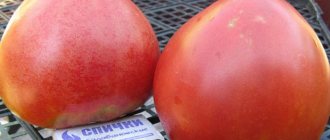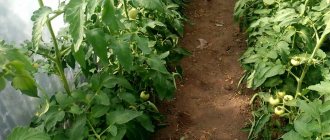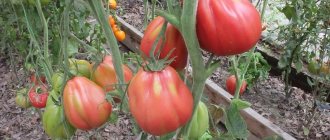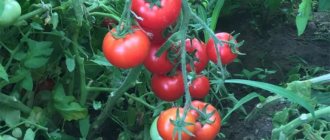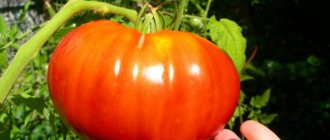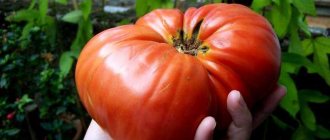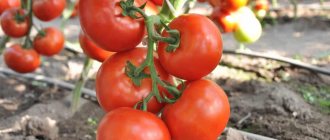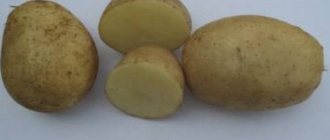Description of the tomato variety Pink Flamingo
This is a relatively new, but quite well-known and popular variety. Its applicants in 2004 were Agrofirm Poisk LLC and the Federal State Budgetary Institution Federal Scientific Center for Vegetable Growing. After variety testing in 2007, Pink Flamingo was included in the State Register of Breeding Achievements of Russia. The crop is recommended for cultivation in open ground on private farms.
The originator of the Pink Flamingo tomato variety is Agrofirm Poisk.
Growing regions
The plant turned out to be heat-loving, so the State Register issued a permit for the North Caucasus region. But, according to reviews, it can be judged that the variety has taken root and bears fruit well in the Central region. True, in cooler climates they grow it under film covers or in greenhouses.
Appearance
Based on official data, the variety can be classified as determinant, that is, low, self-fulfilling. The height in open ground, according to the originator’s description, is only 40–50 cm. The shoot-forming ability and foliage are moderate. The leaves are medium-sized, slightly corrugated, juicy green in color. The inflorescence is simple, each cluster bears 4–5 fruits. The tomatoes on the first bunches are larger than on the subsequent ones. Pedicel with articulation.
The fruit has a beautiful round shape, moderately dense, with slight ribbing at the stalk. Average weight 75 – 110 g . An unripe tomato is light green, with a small varietal dark green spot. During the period of ripeness, the fruit becomes pink-crimson, the spot disappears. The skin is thin, glossy. The pulp is fleshy, sugary at the break, very tender, juicy, but not overly watery. The color is pale pink. There are no voids in the fruit, there are from 4 to 6 seed chambers. The taste of ripe tomatoes and freshly squeezed juice is excellent . 100 g of juice contains:
- dry matter - 5.6 - 6.8%;
- sugars - 2.6 - 3.7%.
The variety-tested Pink Flamingo tomato has a round shape
Characteristics
- Pink flamingos are mid-season. The harvest can be harvested 100 - 105 days after the appearance of full shoots;
- after variety testing, the State Register noted good productivity - 234 - 349 c/ha. If we compare it with the Dary Zavolzhye variety taken as a standard, then the minimum indicator of Pink Flamingo is lower - 176 c/ha, but the maximum is higher - 362 c/ha;
- the yield of marketable products is not bad - 68 - 87%;
- vegetable growers note high resistance to the main diseases of the crop - tobacco mosaic virus, fusarium and late blight;
- thin skin does not prevent tomatoes from cracking;
- the rosy-cheeked variety may suffer from so-called green shoulders, which are formed either due to too cold weather or due to a lack of microelements;
- transportability is not good enough, fruits may become wrinkled during transportation and lose their presentation;
- keeping quality is poor, it is advisable to immediately eat or process the harvested crop;
- The method of consumption is primarily salad, but ripe tomatoes make excellent tomato products. The variety is not suitable for whole-fruit canning - the skin bursts after heat treatment.
If there is a lack of potassium, the Pink Flamingo tomato may have green hangers.
How to grow seedlings
Many gardeners prefer to grow their own seedlings. The optimal time is 50-60 days before the intended planting in the ground.
If sowed too early, the seedlings stretch out and take root poorly. Before sowing, you should prepare everything you need. Consider below an overview of useful tips for growing seedlings.
Seed preparation
Seeds need pre-treatment. For example, you can soak them in a solution of Agricola Vegeta liquid fertilizer. The temperature of the solution should be at least 20 degrees, the soaking time should be 24 hours.
For convenience, it is recommended to place the seeds in a bag, and only then into the solution. Then you can put them in the same bag in the refrigerator for two days, after which you can immediately plant them as seedlings. This will make the plant immune to frost.
It would not be a bad idea to germinate the seeds. To do this, put them in a damp bag and leave them in this form until the first entrances. However, some gardeners are against germination - they claim that the soil best accepts dry seeds.
Container and soil
For seedlings, flower pots, plastic cups, and boxes are used. Often gardeners prefer to grow seedlings in peat pots. Firstly, the porous surface provides the necessary water-air regime inside it, which is why the seedlings develop faster. Secondly, peat pots are made from environmentally friendly material and are highly durable.
It is necessary to plant seedlings only in specially prepared soil. The ideal mixture should contain:
- humus - is a mixture of grass and manure;
- peat - is responsible for the level of moisture in the soil, and also contributes to the creation of good looseness;
- sand or sawdust - serve as natural leavening agents;
- leaf soil - saturates the seedlings with additional nutrients.
Preparing the soil for seedlings involves mixing the components listed above. To do this, you can spread polyethylene on the floor and pour on it in a 4:1 ratio of parts of humus to parts of the remaining components. To obtain the most effective result, it is recommended to add half a bucket of wood ash.
On the day of sowing, slightly moist soil is poured into the cups, compacted a little and watered again with warm, settled water. It is recommended to add growth stimulator “Bud”. Then make a hole 1.5 cm deep in each cup, place a seed in it and sprinkle soil on top. It is best to sow early in the morning.
Growing and care
The containers are placed in a bright and warm place. The air temperature must be at least 25 degrees. After 5-6 days, you can put film or special caps on the containers. This is necessary for the fastest appearance of inputs. After this, the film is removed.
During the first 20 days, seedlings grow slowly. To prevent it from stretching, it is recommended to monitor the lighting and air temperature. It is best to water young seedlings at the root so that moisture does not get on the leaves and stem.
When the seedlings have one leaf each, organize the first feeding. To do this, you can use the growth stimulator “Kornerost”. As the name suggests, the drug strengthens the root system and gives the plant additional development.
Seedlings should be watered once a week. Do not allow the soil to dry out or become waterlogged. Also, never water the seedlings with cold tap water. All this can lead to vegetables cracking and losing their taste.
The pink flamingo loves fertile soils and high-quality fertilizers. Therefore, before planting, it is necessary to study all biotechniques and care tips.
Landing
Seedlings are planted in the ground around the end of May-beginning of July. It is recommended to plant pink flamingos in a greenhouse, since in open ground the yield is significantly reduced. Tomatoes do not like acidic soil, so avoid areas where potatoes were previously planted.
It is also necessary to disinfect the soil and hard surfaces in the greenhouse in advance. To do this, dilute a solution of potassium permanganate and wipe the structure with it, and simply water the ground.
First of all, the variety needs to be formed. To do this, pinch the side shoots and remove the lower leaves. Formation allows the plant to receive more air and light, and also improves the amount of future harvest, since the bush has more resources.
Also, the Pink Flamingo needs to be watered regularly with settled water. Sometimes, to prevent disease, you can add an infusion of garlic or dandelion to the water. Make sure that the main moisture falls under the root and not on the stem or leaves. In addition to watering, remove stepchildren in a timely manner - these are additional shoots that need to be carefully plucked off every 10-12 days.
Monitor the air temperature and humidity. Average daily temperatures should be from 16 to 28 degrees. At low temperatures, growth slows down, and at higher temperatures, the risk of cracking of tomatoes increases. Many gardeners use a drip irrigation system to care for their crops. This is an ideal solution for moistening the soil.
In addition, monitor the amount of fertilizer applied. Sometimes there is an excess of nitrogen-containing substances, as a result of which the bushes wither and die. To prevent this from happening, it is recommended to alternate mineral and organic fertilizers. Among organic fertilizers, ash and mullein perform well.
Diseases and pests
Pink flamingo is a variety with increased immunity to fungi, pests and diseases. However, preventive measures should not be neglected.
For example, as a preventive measure against microorganisms, it is recommended to spray the bushes with a whey solution. The product especially helps against tobacco mosaic. Weekly spraying with plain milk will protect the plant from late blight.
Solutions based on garlic or onion peels are recognized as an effective remedy against insect pests. These folk remedies will not only protect the crop from the Colorado potato beetle, wireworm and other pests, but will also save you money.
For good seed germination and obtaining suitable seedlings you need:
- prepare the soil;
- select a container for pecking;
- treat the seeds against pests and harden them.
Did you know? Tomatoes contain choline, which helps lower blood cholesterol. In addition, it promotes the formation of hemoglobin and strengthens the immune system.
Optimal timing
The time for sowing seeds is the second half of March, the first half of April.
Soil mixture
Tomatoes are demanding on the composition of the soil. If your land is not fertile, you need to do everything to achieve this. It is better if legumes, onions or peas grew in the selected area before. In addition, the soil is disinfected with a solution of copper sulfate, which is carefully poured over it.
Any container with holes made in it to drain excess liquid is suitable for germinating seeds. Whether these are individual cups or a common box depends on personal choice. In addition, you can use peat tablets. In addition, to be sure that all planted seeds will sprout, they can be pre-germinated on cotton wool or paper. These materials are moistened and left in a warm room for some time.
Did you know? The first European recipe that included tomato as an ingredient was published in 1692 in Naples.
Seed preparation
Since the Pink Flamingo variety is grown using seedlings, seed preparation affects the future harvest. This includes their disinfection by soaking in a 1% solution of potassium permanganate for 12 hours and subsequent immersion in a growth stimulator, which will increase the chance of germination after planting the seeds.
Sowing seeds
Seeds are sown in previously prepared soil. It is important not only to maintain a distance of approximately 2 cm, but also a depth of at least 1 cm. The soil is leveled from above, watered with water and covered with film. The container is placed in a warm place where the temperature is within 22... 25 °C; at this time, a lot of sunlight is not needed.
Seedling care
After the first shoots appear, the film is removed from the container and the temperature is gradually lowered to 15 °C.
At this time, the amount of light needs to be increased, but to form symmetrical leaves, the containers need to be rotated every two days. At this time, seedlings need systematic watering. Two weeks after emergence, fertilize with any organic fertilizer.
Hardening of seedlings
In order for the plants to take root better after transplanting to a permanent place, it is recommended to harden them. This should be done several weeks before planting.
It is carried out as follows: the container with seedlings is taken to a place where the temperature is at around 10 ° C, and the seedlings are left there for no more than 2 hours. This should be done for several days in a row, increasing the length of time the plant stays in the cold.
At the age of 60–70 days, seedlings are planted in the ground. The outside temperature should be consistently above 15 °C. Tomato bushes are planted according to a 70x40 cm pattern. Afterwards, the soil is thoroughly filled with warm water.
Features of Pink Flamingo, comparison with other pink-fruited varieties, advantages and disadvantages
The special features of the Pink Flamingo are its excellent taste, which is confirmed by numerous positive responses from tomato growers, as well as its excellent yield, given its short stature.
Table: comparing the Pink Flamingo tomato with pink-fruited varieties
| Variety | Fruit weight | Productivity | Ripening period | Sustainability |
| Pink flamingo | 75 – 110 g | 234 – 349 c/ha | 100 – 105 days | According to reviews - to TMV, fusarium, late blight |
| wild Rose | 300 – 350 g | 6 kg per 1 m2 | 110 – 115 days | To the TMV virus, but may suffer from late blight |
| Eagle beak | 228 – 360 g | 10.5 – 14.4 kg per 1 m2 | 105 – 115 days | There is no information in the State Register |
| De Barao pink | 50 – 70 g | 5.4 – 6.8 kg per 1 m2 | 117 days | There is no information in the State Register |
Unlike Pink Flamingo, De Barao Pink has smaller fruits and ripens later
Table: advantages and disadvantages of the variety
| Advantages | Flaws |
| Beautiful appearance of fruits | Poor transportability and keeping quality |
| High yield | Fruit cracking |
| Excellent taste | Green hangers |
| Universal use of the crop | |
| Good immunity according to reviews from vegetable growers |
Tomato Pink Flamingo - one of the most delicious pink varieties
Harvesting and application
It is best to harvest Pink Flamingo when the tomatoes are already ripe and have acquired shine. But it is also not prohibited to collect vegetables a little earlier and place them in a dark, cool place until fully ripe. It is not recommended to store tomatoes in the refrigerator. Cold spoils their taste and slows down ripening.
Vegetables are used in the preparation of pizzas, salads, sandwiches, salsa, soups, juices and many other dishes. Pink flamingo has a sweetish taste, so it will harmoniously complement almost any food.
Tomatoes are even used in the preparation of cosmetic care products. For example, a mask made from tomato juice and glycerin is widely popular. It moisturizes the skin and has a healing effect against acne.
Tomato is also used in folk medicine. Even simple fresh consumption has a beneficial effect on human health.
The vegetable is capable of:
- regulate metabolic processes;
- strengthen the functioning of the kidneys and gonads;
- improve mood and cope with stress;
- regulate the activity of the gastrointestinal tract.
"Flamingo" is suitable for a wide variety of culinary uses:
- Fresh consumption;
- Cutting into salads;
- Cooking heat-treated dishes;
- Whole fruit preservation;
- Barrel salting;
- Processing into juice, paste, lecho.
The harvested crop is stored for several months without losing its marketable properties, and is transported to any distance without deforming the fruit. Therefore, “Flamingo” is widely grown in large farms for sale.
Features of cultivation and planting
It is recommended to grow pink flamingos in seedlings. Sowing time is mid-March. If it is intended to grow the plant under film covers, then sowing is carried out in early March. The main thing is that by the time the plant is transplanted to a permanent place, it is already 60 days old. Seed preparation is carried out in the usual way. When growing seedlings, generally accepted rules are followed. But as you know, pink-fruited tomatoes are very demanding on agricultural technology. And Pink Flamingo is no exception.
By the way, about sowing dates. In Crimea, it is customary to sow tomato seeds for seedlings very early - in the middle or end of February. The fact is that after transplanting the seedling into the ground, a hot period quickly sets in, and if you adhere to generally accepted deadlines, the plants begin to burn in the sun. And the early sowing procedure allows tomatoes to form normally before the onset of heat.
Nuances of agricultural technology
To get a truly decent harvest of delicious tomatoes, you need to know some of the subtleties associated with the growing process:
Recent Entries
5 working ways to use tar in the garden 7 indoor plants that help you get married even in adulthood Indoor plants that can bloom in trouble
- Well-lit areas are allocated for the garden bed; under the sun's rays, the fruits acquire greater sugar content and better taste;
- at the time of active growth of green mass, watering should be plentiful, but not excessive. As soon as the fruits begin to ripen, moisture is reduced to avoid cracking of the tomatoes;
- If there is a lack of potassium, green shoulders will appear. Therefore, it is best to use universal balanced fertilizers as fertilizers, containing the elements necessary for the crop in the required proportions.
Subject to relatively simple agricultural techniques, Pink Flamingo tomatoes will strive for perfection
Planting scheme and bush formation
The standard planting pattern is used - 30 - 40 cm between bushes in a row and 70 cm row spacing. Whatever variety of Pink Flamingo you grow, the bush must be tied up. The low-growing variety can be grown as a cola crop and formed into 2–4 stems. It is better to tie a tall plant to a trellis and form it into 1 - 2 stems.
Outdoor care
To get maximum yield, proper care of tomatoes is important. This includes watering, fertilizing, as well as bush formation and preventive measures against diseases.
Preventive measures against diseases are carried out using
brilliant greens
.
Over-wetting the soil is just as harmful to tomatoes as long-term drought. At first, a small amount of water is needed so that the plant forms a complete and strong root system that will absorb moisture from the ground. After 20 days, watering is carried out once a week. This should be done in the evening or early in the morning and with warm water, otherwise the tomato will start to hurt.
At high ambient temperatures, the period between waterings is reduced, and in cloudy weather, on the contrary, they are increased. After the ovaries appear, water is given every 3 days. The main thing is to monitor the moisture level, since waterlogging increases the risk of fungal diseases; in addition, the plants stretch upward and the leaves grow.
Important! Watering can be drip or regular. The main thing is that water does not get on the leaves and ovary, otherwise the plant may die.
Top dressing
After 2 weeks, the soil is fed with fertilizers. This could be wood ash or bird droppings. On average, fertilizing is carried out at least five times per season. This needs to be done twice a month.
You can purchase specially developed mineral fertilizer complexes in stores, for example:
- "Kemira Lux";
- magnesium sulfate;
- "Universal";
- calcium nitrate;
- "Solution";
- potassium monophosphate.
Stepsoning
The culture is formed into 1 or 2 stems, the remaining weak shoots are pinched. This is done so that the main stem does not lack nutrients. To obtain good-sized fruits, it is recommended to leave no more than 5 clusters.
Soil care
The land needs care, which includes getting rid of weeds that absorb moisture and nutrients from the soil. After watering, the soil is loosened to reduce moisture loss. In addition, such actions will increase the penetration of oxygen into it. Another way to preserve moisture is mulching; this can be done using dry grass or compost, which is laid out around the bushes and between the rows.
We suggest you read: Which tomato seeds are best for open ground
Tying up bushes
Since the plant has very tall stems, so that they do not break under the weight of the fruit, it is recommended to tie them up already at the stage of bush formation. If there are a small number of plants, then you can use rods: each is inserted close to the trunk, and connected to each other using a rope. For large quantities, you can make trellises; their height should be about 3 m. The bushes are tied using a nylon rope, which will not damage them, but will secure them.
"Pink flamingo" is resistant to many diseases and pests.
However, for good health, prevention should not be neglected:
- To prevent blackleg, the ground is treated with a solution of potassium permanganate (prepared at the rate of 5 g per 10 liters of water).
- Late blight is sprayed with a 10% salt solution, and in addition, potatoes in the neighborhood are planted at a distance of more than 5 m.
- For spider mites, treat the leaves with Fitoverma solution.
- For blossom end rot, watch out for calcium in the soil and low moisture levels.
- It is recommended to treat planting material against bacterial cancer.
If you get a small harvest of tomatoes, then the main reason for this is improper care of the bushes, since certain varieties of tomatoes need not only to be planted and watered. It is required to carefully care for tomatoes, follow all agrotechnical practices, and create the best conditions for the crop in order to get an excellent harvest as a result.
To grow seedlings in the future, in the fall, scatter 4 kg of humus or compost per 1 m² of land and dig up to the depth of a shovel. Remove all weeds and roots. In the spring, scatter 80 g of superphosphate and 20 g of potassium chloride per 1 m², and dig up the ground again.
Experienced gardeners advise planting tomatoes in the area where green manure previously grew: white mustard, phacelia, Shrovetide radish, lupine, vetch, alfalfa.
Try sowing these crops in early spring, before placing the seedlings in the ground. Then plant tomato seedlings next to the green manure. From time to time, mow the green manure and place it under the bushes as mulch. But each type of green manure can be planted in one place for no more than 1 - 2 years, and then sow another type.
The productivity of the Pink Flamingo variety depends on proper plant care:
- The stem of the indeterminate requires garter. To do this, pegs are driven in next to the stem and tied with twine several times a season as the shoot grows.
- It is necessary to form a tomato bush into 1 or 2 stems. Unnecessary stepsons are torn off, which makes it possible to collect large fruits. The first stepson is left above the first flower brush.
- In order for the fruits to ripen quickly, in early August you need to pinch the top of the main shoot. In this case, leave 2-3 leaves above the top flower brush. If the stem is short, this is not necessary.
- The variety is fed 3-4 times per season, starting with organic fertilizers, alternating them with mineral ones.
- Water vegetable bushes regularly, reducing the frequency of watering before flowering.
Sugar fruits are harvested as they ripen.
Varieties of the same name
And now about why the same variety has differences in external description and characteristics. The fact is that Ukraine has its own (and even more than one) Pink Flamingo.
Seed growers and GL SEEDS that sell the seeds describe the crop as semi-determinate, 1.2 - 1.5 m high. The shape of the fruit is also different - it ranges from flat-round-conical to elongated-heart-shaped. The weight of a tomato from different manufacturers can be 150 g or 300 - 400 g. The ripening period of these varieties is slightly longer than that of the variety described by the State Register.
The pink flamingo of Ukrainian selection has the shape of an elongated heart
There is also a variety from Biotechnika . It is also declared as tall, with a fruit weight of 150 to 170 g. Its shape is more like a plum-shaped one. Racemes of intermediate type, numbering about 10 (or more) ovaries.
The Pink Flamingo tomato from Biotechnika looks like cream
Of course, the popularity of the variety has led to the fact that many tomato growers are already confused about which of the varieties being grown is correct. Some even boast about the Pink Striped Flamingo . First of all, you need to trust official information - the State Register. Well, if you like elongated fruits, buy seeds of the Ukrainian variety, especially since it also bears fruit well here.
The popularity of the Pink Flamingo led to the appearance of a striped variety
Agricultural technology
Of course, it is best to grow such a capricious species using seedlings. Seed material is sown in March. Picked and hardened seedlings are ready for transplanting into the ground after 2 months. Despite the fact that the growing recommendations do not contain instructions on tying up the bush, it is still better to do this so that the stem does not fall over. The planting pattern is usual - 40 cm between plants and 50 cm row spacing, maybe a little more. It is recommended to form into 1 or 2 stems. A sunny area is allocated for growing the variety; it is desirable that the predecessors be dill, parsley, zucchini, and cauliflower.
To get a tomato harvest that will not disappoint, you will have to familiarize yourself with the rules of agricultural technology. Watering is moderate but sufficient. If the soil is waterlogged, the Pink Flamingo fruits will crack; overdrying is also unacceptable. Watering is carried out with warm water, preferably in the evening, making sure that the liquid does not fall on the leaves. The first feeding is carried out 2 weeks after planting the seedlings in the ground. Organic and universal mineral fertilizers are acceptable as fertilizers. The nutrient solution is applied only to moist soil so as not to burn the roots. It is imperative to carry out preventive treatments against diseases and pests. In closed ground, it is necessary to strictly control air humidity; if this figure exceeds 65%, the plant may be affected by fungal diseases and show a decrease in yield.
Due to the fact that Pink Flamingo is extremely popular, the described variety can also be purchased on the seed market from other manufacturers. Despite the same names, the appearance and characteristics of these crops will vary. We won’t list everything, but we’ll focus on the most common ones.
- "Agrofirm Biotekhnika" The plant is semi-determinate, 1.2 - 1.5 meters high. Tomatoes have the shape of large cream, pink color, weight from 150 to 170 grams. The taste is excellent. The tomato is high-yielding, stores well, and is used for whole-fruit canning. In terms of ripening time, it is medium early, from germination to harvest it takes 110 - 115 days. It is recommended to form 3 - 4 stems with 6 -7 brushes.
- Trademark "Veles". The plant is semi-determinate, the height of the bush is 1.2 - 1.5 meters. The shape of the pink-fruited tomato is elongated and heart-shaped. The pulp is fleshy, sugary. Weight - from 150 to 400 grams.
- GL SEEDS. Indeterminate tomato, up to 1.5 meters high. The fruits are flat-round-conical in shape and look very original. Painted in pink-raspberry color, the taste is excellent. Fruit weight - 300 - 400 grams. The variety is mid-early, with a growing season of 130 - 135 days.
There is also information that the described variety has another name - Bells of Russia. But this is incorrect information. The Bell Tomato of Russia is a separate species, also registered in the State Register, but a little earlier - in 2000. And his applicants are different.
Although the pink flamingo from Agro requires a special approach, it undoubtedly pleases with the taste of the fruit. Of course, it will be difficult for an inexperienced gardener to immediately get an excellent result, but you certainly shouldn’t give up. Before growing this variety, make sure that the climate in your region is suitable for its cultivation. If the summer is cold and capricious, it is best to plant tomatoes in a greenhouse.
Harvesting and application
“Flamingo” is characterized by a sharp transition from blanche to technical maturity against the backdrop of a rather slow overall development. On days 105-110, the gardener has the feeling that the tomatoes will no longer have time to ripen on time, but in recent days they are rapidly gaining weight and changing color from brown to signal red. From each bush you can remove up to 5 kg of marketable fruit.
IMPORTANT: If the storage conditions are observed, the collected fruits retain their commercial quality until the end of December.
“Flamingo” feels best in the central regions: Bryansk, Voronezh, Moscow regions. However, nominal yields can be achieved when grown in the south in open ground or in the north in a stationary heated greenhouse.
The harvest takes a long time, until October. In addition to fully ripened fruits, you can also pick slightly green ones. This variety ripens easily in a warm room. Tomatoes do not lose their quality for 2 months after harvest.
Despite the difficulties of cultivation, the resulting harvest is worth the effort. We hope our article will help you avoid problems and enjoy delicious fruits from your garden.
From 1 m2 they collect 8-10 kg.
Diseases and pests
Thanks to the “wild” parents used by breeders when breeding the variety, “Pink Flamingo” is resistant to most diseases. But, susceptible to crown rot. When the first signs of the disease appear: rusty spots, blackening of the base of the fruit, the plants are immediately fed with phosphorus-potassium fertilizers and sprinkled with wood ash.
It is very important to have an understanding of such common tomato diseases as Alternaria, Fusarium, Verticillium, and late blight. Also on our website you will find information about protection against late blight and about varieties that are not susceptible to this scourge.
As for pests, the Colorado potato beetle, aphids, thrips, spider mites and slugs most often attack tomatoes.
“Pink flamingo”, with all its demands on soils, delicate watering and average yields, is loved by vegetable growers for its excellent taste, aroma, and presentation.
If you find an error, please highlight a piece of text and press Ctrl Enter.
Bushes are extremely rarely affected by late blight.
"FlamingoF1" is highly resistant to diseases:
- Cladosporiosis;
- Tobacco mosaic virus;
- Curling of leaves;
- Fusarium;
- Nematode.
To prevent fruit cracking, it is recommended to maintain the humidity regime in the greenhouse (no more than 60%) and balanced watering.
Disinfection of seeds and soil is carried out to stop diseases in the bud. Preventive spraying with microbiological preparations against diseases and pests is carried out several times a season.
The tomato variety "Flamingo F1" is one of the best semi-determinate Russian tomatoes; it does not require special attention and produces an excellent harvest. We wish you excellent harvests on your plots!


